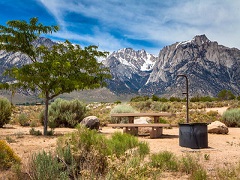BLM Bishop Field Office issues seasonal fire restrictions
Organization:
BLM Office:
Media Contact:
 BISHOP, Calif. – The Bureau of Land Management is issuing seasonal fire restrictions for public lands managed by the Bishop Field Office in the Eastern Sierra effective Monday, June 8, due to increased wildland fire danger in the region. These seasonal restrictions will remain in effect until November 1, and are in addition to the year-round statewide fire prevention order, issued on April 28.
BISHOP, Calif. – The Bureau of Land Management is issuing seasonal fire restrictions for public lands managed by the Bishop Field Office in the Eastern Sierra effective Monday, June 8, due to increased wildland fire danger in the region. These seasonal restrictions will remain in effect until November 1, and are in addition to the year-round statewide fire prevention order, issued on April 28.
The BLM-managed public lands subject to these fire restrictions extend from the southern Owens Valley in Inyo County, north to Topaz Lake, and the Nevada border in Mono County. These fire restrictions also apply to popular BLM-managed recreational areas in the region, including the Alabama Hills National Scenic Area, Inyo Mountains Wilderness, Volcanic Tableland, Long Valley, Adobe Valley, Mono Basin, Bodie Hills, Bridgeport Valley and Slinkard Valley. BLM seasonal fire restrictions for the Eastern Sierra Region are being implemented in close coordination with the Cal Fire San Bernardino/Inyo/Mono Unit.
On average, human-caused wildfires make up 95 percent of all wildfires in California. Many of these wildfires occur along roadways, adjacent to communities and within recreational areas, posing considerable threat to public safety. In 2019, more than 170 wildfires burned on nearly160,000 acres of BLM-managed public lands in California. Taking individual responsibility to reduce wildfire risk while recreating on public lands, and to provide defensible space around homes and within communities before a fire occurs, can help keep property, the public, and firefighters safe.
The following restrictions will remain in place until fire dangers subside:
- No campfires, barbecues, or open fires, except in a fire ring or fire pit specifically provided for such use in the following developed campgrounds: Tuttle Creek, Goodale Creek, Horton Creek, Crowley Lake and Pleasant Valley Pit. Portable stoves with gas, jelled petroleum, or pressurized liquid fuel are allowed with a valid California campfire permit available free at all BLM, U.S. Forest Service and Cal Fire offices, or at www.readyforwildfire.org/permits/campfire-permit/.
- No tools powered by internal combustion engines off BLM designated roads or trails (such as chainsaws or lawn mowers).
- No smoking, except within an enclosed vehicle or camp trailer, or while stopped/standing in a designated developed campground with a three-foot diameter area barren or cleared of all flammable materials.
- No motorized vehicles off BLM designated roads or trails.
- No fireworks, including “safe and sane” fireworks.
- Target shooters may not use incendiary, exploding, tracer, steel core, steel jacketed or armor piercing ammunition. No steel targets allowed – hot bullet fragments, exploding targets and metal from recreational shooting can spark a wildland fire. Hunters actively engaged in the legal pursuit and take of game and non-game species must have a valid California hunting license and abide by California laws and regulations.
- No welding or operating acetylene or other torch with open flame.
Anyone found guilty of violating a fire prevention order may be fined not more than $100,000 and/or face imprisonment for not more than 12 months. Restitution for total fire suppression and damage costs incurred may be borne by the trespasser.
To learn how you can do your part to prevent wildland fires visit www.readyforwildfire.org. A listing of fire restrictions throughout BLM California is available at https://go.usa.gov/xmUEG. For specific questions, please contact the Bishop Field Office at 760-872-5000.
The BLM manages about 245 million acres of public land located primarily in 12 western states, including Alaska, on behalf of the American people. The BLM also administers 700 million acres of sub-surface mineral estate throughout the nation. Our mission is to sustain the health, diversity, and productivity of America’s public lands for the use and enjoyment of present and future generations.
